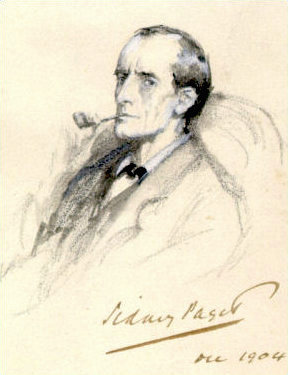
Sherlock Holmes is a fictional detective created by British author Arthur Conan Doyle. Referring to himself as a "consulting detective" in his stories, Holmes is known for his proficiency with observation, deduction, forensic science and logical reasoning that borders on the fantastic, which he employs when investigating cases for a wide variety of clients, including Scotland Yard.
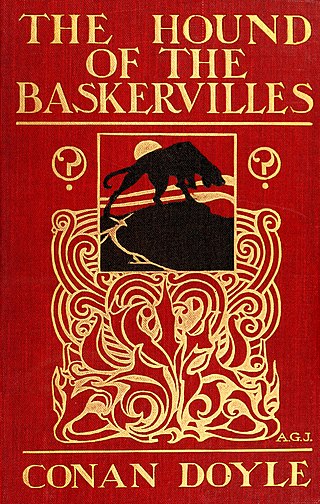
The Hound of the Baskervilles is the third of the four crime novels by British writer Arthur Conan Doyle featuring the detective Sherlock Holmes. Originally serialised in The Strand Magazine from August 1901 to April 1902, it is set largely in Dartmoor, Devon, in England's West Country and follows Holmes and Watson investigating the legend of a fearsome, diabolical hound of supernatural origin. This was the first appearance of Holmes since his apparent death in "The Final Problem", and the success of The Hound of the Baskervilles led to the character's eventual revival.

Hindhead is a village in the Waverley district of the ceremonial county of Surrey, England. It is the highest village in the county and its buildings are between 185 metres (607 ft) and 253 metres (830 ft) above sea level. The village forms part of the Haslemere parish. Situated on the county border with Hampshire, it is best known as the location of the Devil's Punch Bowl, a beauty spot and site of special scientific interest.

George Edward Challenger is a fictional character in a series of fantasy and science fiction stories by Sir Arthur Conan Doyle. Unlike Doyle's self-controlled, analytical character, Sherlock Holmes, Professor Challenger is an aggressive, hot-tempered, dominating figure.

The Exploits of Sherlock Holmes is a short story collection of twelve Sherlock Holmes pastiches, first published in 1954. It was written by Adrian Conan Doyle, who was the son of Sir Arthur Conan Doyle, and by John Dickson Carr, who was the authorised biographer of the elder Conan Doyle. The first six stories were written in collaboration by the two writers, while the last six stories were written solely by Adrian Conan Doyle.

Detective Inspector G. Lestrade is a fictional character appearing in the Sherlock Holmes stories written by Arthur Conan Doyle. Lestrade's first appearance was in the first Sherlock Holmes story, the 1887 novel A Study in Scarlet. His last appearance is in the 1924 short story "The Adventure of the Three Garridebs", which is included in the collection The Case-Book of Sherlock Holmes.

Air Commandant Dame Lena Annette Jean Conan Doyle, Lady Bromet, was a British Women's Royal Air Force officer.
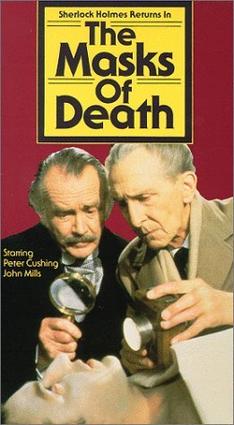
The Masks of Death is a 1984 British mystery television film directed by Roy Ward Baker and starring Peter Cushing as Sherlock Holmes and John Mills as Doctor Watson.
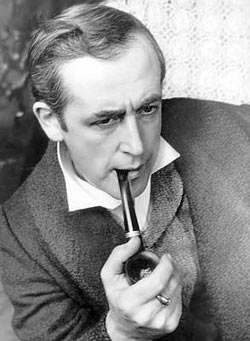
The Adventures of Sherlock Holmes and Dr. Watson is a series of Soviet television films portraying Arthur Conan Doyle's fictional English detective, starting in 1979. They were directed by Igor Maslennikov.

Sir Arthur Ignatius Conan Doyle was a British writer and physician. He created the character Sherlock Holmes in 1887 for A Study in Scarlet, the first of four novels and fifty-six short stories about Holmes and Dr. Watson. The Sherlock Holmes stories are milestones in the field of crime fiction.

Cromer Hall is a country house located one mile south of Cromer on Holt Road, in the English county of Norfolk. The present house was built in 1829 by architect William Donthorne. The hall is a Grade II* listed building.
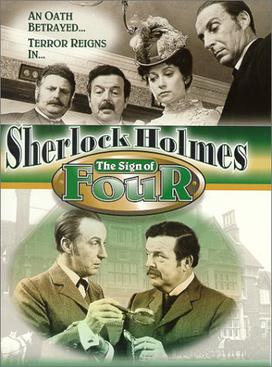
The Sign of Four is a 1983 British made-for-television mystery film directed by Desmond Davis and starring Ian Richardson and David Healy. The film is based on Sir Arthur Conan Doyle's 1890 novel of the same name, the second novel to feature Sherlock Holmes and Doctor Watson.
The Sign of Four (2001) is a Canadian television film directed by Rodney Gibbons and starring Matt Frewer and Kenneth Welsh. The movie is based on Arthur Conan Doyle's second Sherlock Holmes novel published in 1890.

The Hound of the Baskervilles is a 1983 British made-for-television mystery thriller film directed by Douglas Hickox, starring Ian Richardson as Sherlock Holmes and Donald Churchill as Dr. John H. Watson. It is based on Arthur Conan Doyle's 1902 novel The Hound of the Baskervilles.
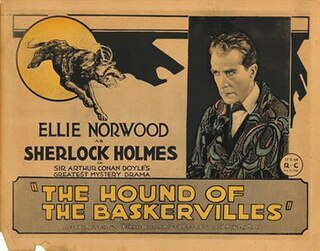
The Hound of the Baskervilles is a 1921 British silent mystery film directed by Maurice Elvey and starring Eille Norwood, Catina Campbell and Rex McDougall. It is based on the 1902 Sherlock Holmes novel The Hound of the Baskervilles by Arthur Conan Doyle. It was made by Stoll Pictures, Britain's largest film company at the time. It was the first British film adaptation of the famous novel.
Daniel Stashower is an American author and editor of mystery fiction and historical nonfiction. He lives in Maryland.
Sherlock Holmes fandom is an international, informal community of fans of the stories by Arthur Conan Doyle featuring the fictional detective Sherlock Holmes. The fans are known as Sherlockians or Holmesians. Many fans of Sherlock Holmes participate in societies around the world, and engage in a variety of activities such as discussion, tourism, and collecting.

Joseph Henry Ball (1861–1931) was a British architect. Among his commissions was Undershaw in Hindhead, Surrey, which was built for the family of the writer Arthur Conan Doyle.
"The Field Bazaar" is a short story by Arthur Conan Doyle, first published on November 20, 1896 in a special "Bazaar Number" of The Student, a publication of the students' representative council at Edinburgh University. It is a Sherlock Holmes story, published under Conan Doyle's byline and featuring both Holmes and his partner, Dr. John Watson. It is, however, treated by most experts as a parody or pastiche not suitable for inclusion in the traditional 60-story canon of Sherlock Holmes, though there are dissenters.
Sherlock Holmes is the overall title given to the series of radio dramas adapted from Arthur Conan Doyle's Sherlock Holmes stories that aired between 1952 and 1969 on BBC radio stations. The episodes starred Carleton Hobbs as Sherlock Holmes and Norman Shelley as Dr. Watson. All but four of Doyle's sixty Sherlock Holmes stories were adapted with Hobbs and Shelley in the leading roles, and some of the stories were adapted more than once with different supporting actors.

















